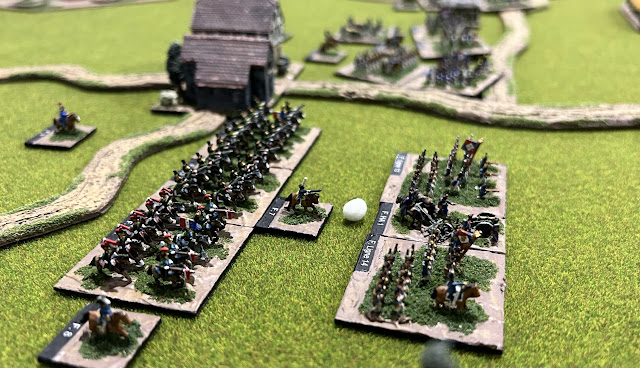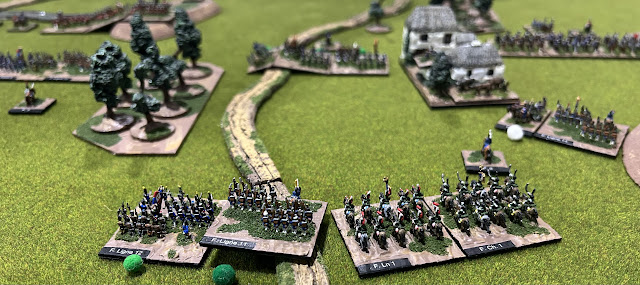The following is a short report of a recent fictional engagement set in early June 1815. Unlike many of our regular games this engagement involved just two players. Despite this it provided an outstanding game as both commanders desperately tried to secure victory.
On the 9th of June Napoleon began his advance against the Allies deployed in Belgium. Crossing the border French forces quickly drove in the various outposts and Napoleon began to envelope the Coalition armies by moving towards Mons west of Brussels. As Wellington had feared this move could cut his communications with the ports he relied on for supply.
The force protecting the right of the main French advance was that commanded by Marshal Grouchy and comprised two corps, those of Vandamme and Gerard. While additional French forces were to demonstrate against the Prussians, Grouchy was ordered to pin the Anglo-Dutch to his front and attack if circumstances allowed. By the morning of the 10th, and now concentrated, Grouchy decided to strike before the Prince of Orange fully drawn up his army. Grouchy had available some 30,000 bayonets, 5,000 cavalry and 76 cannon. Around noon Grouchy ordered his divisions forward near the town of Le-Petit-Quevy. With drums beating and flags taught in the gentle breeze, that bought some relief to the warm June heat, the advancing French columns reminded many veterans of passed victories. Today would be no different!
Vandamme’s III Corps was deployed south of Le-Petit-Quevy and was to deliver the initial blow. This would be achieved by pinning the 2nd Allied Division then driving the Brunswick Division from the field. Then, with the Brunswickers dispatched, the 2nd Netherland Division would be eliminated. Both these divisions needed to be shattered before the Allied reserves known to be advancing could be deployed. In these endeavours Vandamme was to be reinforced by Pecheux’s Division, drawn from Gerard’s IV Corps. The remaining divisions of Gerard’s IV Corps, reinforced by two cavalry divisions would demonstrate against the Allied left. Grouchy’s attack soon gained momentum with the town of Le-Petit-Quevy quickly seized by a detachment of legere.
Above, a portion of the French right showing Hulot's 14th Division from Gerard's IV Corps with three of the four cavalry brigades to the rear. These brigades are drawn from Strolz's 9th Cavalry Division and Chastel's 10th Cavalry Division, the last comprising two Dragoon brigades.
As noted previously the advance on the French right was to be more limited. Despite this the Chateau Culot was seized around 1.30pm and would remain in French hands for the duration of the battle. It was hoped that the securing of the sprawling complex would limit Allied attempts to threaten the French right.
Above, the infantry divisions of Generals Vichery and Hulot, as well as both French cavalry divisions with Chateau Culot visible on the right. Below, another view now around 2.30pm also from the French perspective and looking north.
Below the view from the Allied position. The Allied cavalry comprises three light cavalry brigades, one of Hussars and two of Light Dragoons. Beyond the Chateau Culot, on the right, is the 3rd Netherlands Division.
With the weight of the French advance pressing the Allied line, and his reserves still not on the field, the Prince of Orange was forced to give ground. This was especially complex in the centre where the Prince was hamstrung in his efforts due to the lack of training of some of his divisions. The French pressed forward focussing their attacks on the Brunswick Division as can be seen below where the Brunswick Division is being softened by French artillery.
Yet as French regiments of the centre moved forward and tried to consolidate their gains they were subjected to a series of attacks around 4.30pm. Below, no fewer than six Allied brigades counterattack. The brigades comprise British, Hanoverian, Netherland, Brunswick and Nassau troops.
The French regiments first wavered, some held but others retreated under the ferocious attack. Grouchy, clearly caught unprepared by the attack now reformed his line. French reserves were thrown forward and more artillery bolstered the faltering position. Yet the allies attacks surged forward again around 5.30pm. The 1st KGL Brigade, commanded by Lieutenant Colonel Georg Carl August du Plat, attacking with notable ferocity a hastily deployed French gun line. Du Plat Peninsular veterans carried the position and, like other brigades involved, shattered the French centre.
Yet, even while the unfortunate events in the French centre were playing out the situation on the French right was to be even more dramatic. Here one British cavalry attack stands out. The 6th Cavalry Brigade, comprising three Hussar regiments, attacked with limited support. Despite this lack of support the charge broke a formation of French Chasseurs who fled in rout disordering another brigade. Pursuing the routing Chasseurs the Allied Hussars then overrun a disordered brigade of French Lancers. In one brief hour the French right was unravelling.
If this was not enough the French right was pressed further when two Allied Divisions arrived on the field, adding their weight to the unfolding disaster. These two divisions had been advancing south on a minor road were Somerset's Heavy Cavalry Division and the 1st Allied Division. With their supporting light cavalry reduced to a disordered rabble Gerard's infantry divisions and Chastel's 10th Cavalry Division had no option but to fall back, though in good order, forming in a new defensive position.
Below, the two infantry brigades of the 1st Allied Division, both comprising British Foot Guards, advance supported by two Light Dragoon brigades - Somerset's cavalry are to the left and not shown.
After six hours of desperate fighting Marshal Grouchy was reluctantly forced to accept the situation was hopeless. His right flank had collapsed and his centre was compromised. He must surrender the field falling back to protect Napoleon's line of communication. The Prince of Orange had secured a well fought victory!
The scenario was developed using the "Road to Glory" scenario system. The French were fully concentrated having selected "Full Deployment - Card #25" from the two cards randomly drawn. The Allies had in contrast had selected "Turning Manoeuvre Left - Card #21" which found their reserve arriving on the French right on turn three. Both armies comprised some 3,000 points of troops, all of which are from the 6mm Heroics & Ros range and are from my collection.










Wonderful report! What a fascinating scenario & after action report.
ReplyDeleteThanks Greg, I appreciate the feedback.
Delete